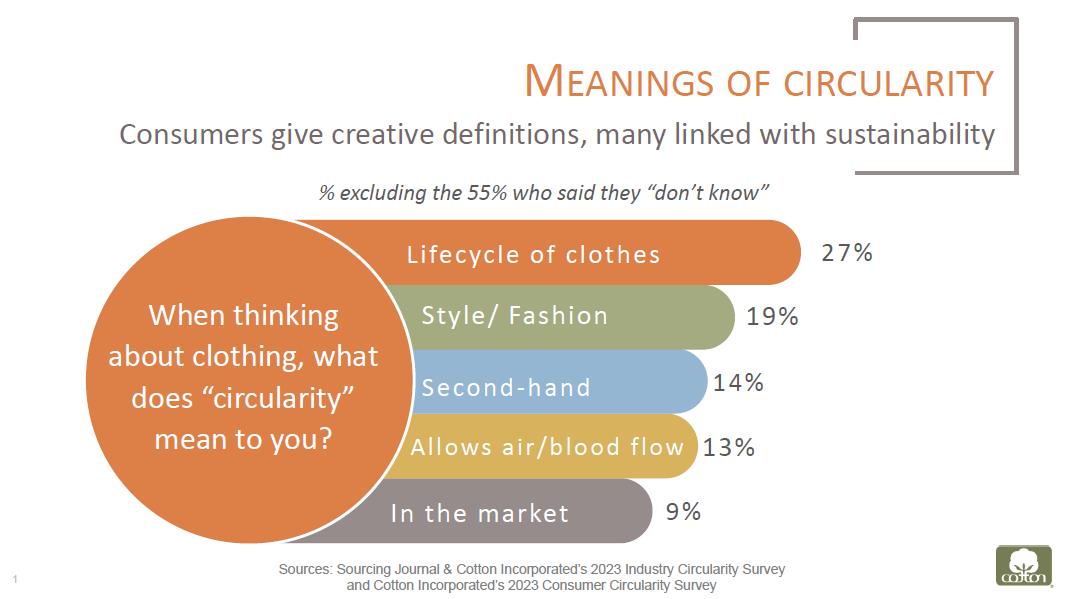
The concept of circularity has gained significant relevance in recent years, as the demand for sustainably produced garments remains a priority for brands and consumers. While consumer definitions of what the term “circularity” means to them vary, most consumers do see a link between circularity and sustainability. Cotton Incorporated’s 2023 Consumer Circularity Survey found that 27% of consumers felt that circularity relates to the lifecycle of clothes [1].
We often think about where our clothes come from, but as the industry shifts in a more sustainable direction, the conversation around where our clothes go after we use them is becoming increasingly important. This is where the lifecycle of clothes comes in – and throughout a cotton garment’s lifecycle, there are multiple opportunities to improve sustainability through closing the loop of production, consumption, and disposal.
Cotton can be reused, recycled [2], and returned to the Earth [3]. Regardless of the product, there can be a circular path for cotton products in the market. And with 84% of industry professionals designing with circularity in mind, cotton is the natural choice for those looking to create products that are durable, biodegradable, and recyclable [4].
For apparel brands and retailers, the commitment to circularity is not just an ethical choice but a strategic one.
Designing with durability, biodegradability, and the potential for reuse and repair in mind is becoming a priority.
This approach not only addresses consumer demand for sustainable products but also anticipates a future where circular fashion practices are the norm, not the exception. The majority of consumers surveyed also show a preference for garments that are sustainable and circular.

71% of consumers are interested in garments that are durable, which leads to a reduction in textile waste due to the longevity of the garment [5]. Cotton is known for its durability, meaning that wearers can take comfort in the fact that their cotton garments will need less frequent replacements than their synthetic counterpart]. 20% of consumers want garments that can be easily repaired – and cotton’s durability means that wearers can extend the lifespan of their clothes through simple at-home repairs and maintenance.
49% of consumers expressed an interest in biodegradability, another key feature of circularity. When a cotton garment finally reaches the end of its life, it can return to the earth safely and quickly under a variety of conditions. As microplastic pollution becomes an increasing problem, choosing fabrics like cotton, whose fibers biodegrade more quickly and thoroughly than synthetics, is important [6].
Despite the obvious benefits of transitioning to a circular model, some industry professionals still find that they’re facing challenges implementing these initiatives. When asked about the challenges they faced, 54% of industry professionals listed passing costs to consumers, 43% faced challenges in understanding how to implement circular logistics, and 42% listed the price of recycled textiles.

Yet with 69% of professionals expressing that consumer interest and demand is the most important factor when deciding how much to invest in circularity [7], the industry recognizes that overcoming these obstacles is essential for long-term viability.
This research underlines the importance of innovation, consumer engagement, and the fashion industry’s commitment to sustainable practices.
[1] Cotton Incorporated’s 2023 Consumer Circularity Survey
[2] Cotton products are recyclable only in a few communities that have appropriate recycling facilities.
[3] Li, Lili; Frey, Margaret; Browning, Kristie (2010). Biodegradability study on cotton and polyester fabrics. Journal of Engineered Fiber and Fabrics.
[4] Sourcing Journal & Cotton Incorporated’s 2023 Industry Circularity Survey
[5] Cotton Incorporated’s 2023 Consumer Circularity Survey
[6] Sourcing Journal & Cotton Incorporated’s 2023 Consumer Circularity Survey
[7] Sourcing Journal & Cotton Incorporated’s 2023 Industry Circularity Survey